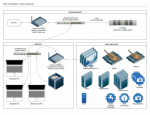rmccullough
Patron
- Joined
- May 17, 2018
- Messages
- 269
I did take a look at the LACP ... friend or foe?, and while I don't want to be naive I think I understand what LAGG/LACP is supposed to do.
I recently purchase an Ubiquiti UniFi Switch 24 (US-24) managed switch. It was highly rated, and you can purchase them new from Amazon for about what they go for used on eBay. It was replacing a TRENDnet 24-Port (TEG-S24Dg) unmanaged gigabit switch. My FreeNAS server has a Supermicro X9DRi-LN4F+ motherboard that provides 4 x Gigabit Ethernet LAN ports (Intel® i350 GbE controller). The idea was to connect my FreeNAS server to the US-24 utilizing all 4 network ports, and allow multiple clients to not have to share a connection with FreeNAS (this is where I get a bit fuzzy on LACP, but that isn't really my question in this thread). So I configured FreeNAS to use all 4 network interfaces in an LAGG (LACP), then configured the 4 ports on the US-24 to aggregate using LACP. I then used IPMI on my Supermicro to restart networking using
Here is what this setup looked like:

Now, I only had the US-24 installed for about 24 hours, and LAGG/LACP configured for about 8 of those. What I noticed was a couple of things:
1) My network performance seemed to not be as good as it was. Accessing the internet was a bit sluggish, almost like it took a couple extra seconds to find the server. I ran some speed tests (fast.com and speedtest.net) and they were close to my numbers before the US-24, but slightly degraded.
2) My MacBook Pro (2017 with TB3/USB-C) had trouble connecting to my FreeNAS server and the services running in jails, but my Windows 10 Pro laptop did not.
3) My WiFi devices started having trouble. They said they were connected to WiFi but no internet was available. I think it was more likely that they could not obtain an IP address from my DHCP server.
I can't say for certain these issues were happening before enabling LACP on the switch, but I know they were happening after it was configured.
At this time I turned off LAGG/LACP on my FreeNAS server and reverted my switch to the TEG-S24Dg. My network is behaving as it was prior to the US-24 being installed.
My question is if this kind of networking issue is typical of enabling LACP? Is it a consequence of mixing consumer hardware (e.g. Linksys router configured as wireless bridge, TRENDnet switches, etc.) with business/enterprise hardware?
I recently purchase an Ubiquiti UniFi Switch 24 (US-24) managed switch. It was highly rated, and you can purchase them new from Amazon for about what they go for used on eBay. It was replacing a TRENDnet 24-Port (TEG-S24Dg) unmanaged gigabit switch. My FreeNAS server has a Supermicro X9DRi-LN4F+ motherboard that provides 4 x Gigabit Ethernet LAN ports (Intel® i350 GbE controller). The idea was to connect my FreeNAS server to the US-24 utilizing all 4 network ports, and allow multiple clients to not have to share a connection with FreeNAS (this is where I get a bit fuzzy on LACP, but that isn't really my question in this thread). So I configured FreeNAS to use all 4 network interfaces in an LAGG (LACP), then configured the 4 ports on the US-24 to aggregate using LACP. I then used IPMI on my Supermicro to restart networking using
/etc/rc.d/netif restart (for some reason this is needed whenever changing network interfaces). After doing this, the LAGG ( lagg0) interface was able to obtain an IP address from my DHCP server. Looking good so far.Here is what this setup looked like:

Now, I only had the US-24 installed for about 24 hours, and LAGG/LACP configured for about 8 of those. What I noticed was a couple of things:
1) My network performance seemed to not be as good as it was. Accessing the internet was a bit sluggish, almost like it took a couple extra seconds to find the server. I ran some speed tests (fast.com and speedtest.net) and they were close to my numbers before the US-24, but slightly degraded.
2) My MacBook Pro (2017 with TB3/USB-C) had trouble connecting to my FreeNAS server and the services running in jails, but my Windows 10 Pro laptop did not.
3) My WiFi devices started having trouble. They said they were connected to WiFi but no internet was available. I think it was more likely that they could not obtain an IP address from my DHCP server.
I can't say for certain these issues were happening before enabling LACP on the switch, but I know they were happening after it was configured.
At this time I turned off LAGG/LACP on my FreeNAS server and reverted my switch to the TEG-S24Dg. My network is behaving as it was prior to the US-24 being installed.
My question is if this kind of networking issue is typical of enabling LACP? Is it a consequence of mixing consumer hardware (e.g. Linksys router configured as wireless bridge, TRENDnet switches, etc.) with business/enterprise hardware?
